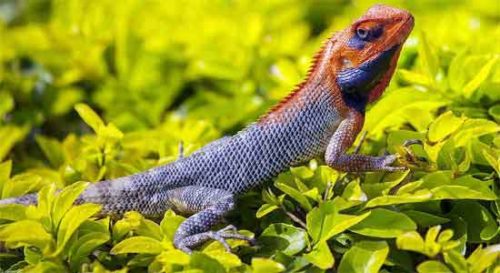Reptiles belong to the class Reptilia under subphylum Vertebrata of phylum Chordata. The representatives of modern reptiles include turtles and tortoises, crocodiles and aligators, snakes, lizards, amphisbaenians and, tuataras. The science which deals with study of modern amphibians and reptiles is collectively called herpetology.
The body size ranges from 17 mm (0.7 inches) to 6 m (19.7 ft) in length. In this case, a tiny gecko (Sphaerodactylus ariasae) can grow up to 17 mm (0.7 in) in length while the saltwater crocodile (Crocodylus porosus) can reach up to 6 m (19.7 ft) in length with over 1,000 kg in weight.
Generally, reptiles are the cold-blooded vertebrate animals which are unable to maintain a definite body temperature. Usually, the body temperature varies with the outside temperature. They have a low metabolic rate and therefore, produce less heat than a bird or mammal. They have evolved from amphibians and in turn, gave rise to the birds and mammals. As a group the reptiles can be separated from the amphibians by their dry cornified scaly skin and from the birds by the absence of feathers and from the mammals by the absence of hairs or furs.
Reptiles are the first group among the vertebrates adapted for life in dry places on land. They have dry horny skin and scales which resist loss of moisture from the body and facilitate living on rough surfaces. Most reptile species live in tropical and subtropical regions and their numbers decline towards the poles and high attitudes. They occupy a wide verity of habitats; some live in the tropics, some in swamps, rivers, estuaries or along the seacoasts.
The reptiles originated during the Carboniferous period, some 300 to 260 MYA and flourished during the Permian period. During the Mesozoic Era, popularly known as the Age of Reptiles (Triassic to upper Cretaceous), they were the dominant vertebrates. During this time, the dinosaurs flourished and some of them far exceeding elephants in length and weight and were greatly diversified as to structure and habits. During Permian, reptiles became numerous as to number of species and began to radiate in both structure and mode of life. By the end of Triassic period, virtually all the major groups of reptiles had appeared and during the Jurassic and Cretaceous these attained a climax as to number of species and individuals and also in diversity of form and manner of life. Then the end of the Cretaceous, the reptiles started to decline and most of the species disappeared and only 4 of the 16 orders survived.
General Characteristics of Reptiles
- They are the cold-blooded vertebrate animals.
- They have dry horny skin, usually with scales or scutes.
- Reptiles have completely ossified skeleton.
- The skull contains one occipital condyle.
- The heart is imperfectly four-chambered.
- Twelve pairs of cranial nerves are present.
- Reptiles perform respiration by lungs.
- They have two pairs of limbs, each with five toes ending in horny claws and suited to running, crawling, or climbing (exception snake and some lizards).
- Limbs are paddle-like in marine turtles and reduced in some lizards.
- Fertilization is internal, usually occurs by copulatory organs.
- Most reptiles are oviparous but some species are viviparous.
- They usually lay eggs but retained in female body for development by some lizards and snakes.
- Eggs are fairly large with much yolk, in leathery or limy shells.
- The new-born resemble adults with no metamorphosis.
- Unlike amphibians, they never depend on aquatic medium for growth and development.
The living or modern reptiles are mostly small and inconspicuous. Majority of them appeared during the Tertiary Period, some 70 MYA. At present the number of living reptile species is over 8700 included under the following four orders:
- Order-1: Testudines-turtles, tortoises and terrapins;
- Order-2: Rhynchocephalia-tuatara;
- Order-3: Squamata-lizards and snakes and
- Order-4: Crocodilia- crocodiles, gavials caimans, and alligators.
Order-1: Testudines
- The order Tesudines contains around 300 extant species in 97 genera.
- The representatives of order Testudines are turtles, tortoises and terrapins, collectively called Testudines.
- They do not contain teeth but each jaw is covered with a horny sheath, form a beak which is sharpened or serrated to cut flesh or plant matters.
- They also contain bony shell comprising an upper carapace and a lower plastron, both composed of solid bony plates. In most cases, this bony shell is further covered by a layer of thick horny scales which form the visible part of the shell but some have a softer, leathery, covering.
- They have strong limbs to lift their heavy bodies. In this case, the shape of the limb is variable, however, in land dwelling species typically the toes are fused into a solid clump, freshwater species having distinct but webbed, toes and marine species having powerful flippers.
- They lay eggs in a nest chamber, but no species displays parental care.
The order Testudines includes the following families:
- Family-1: Carettochelyidae
- Family-2: Chelydridae
- Family-3: Dermatemydidae
- Family-4: Emydidae
- Family-5: Kinosternidae
- Family-6: Platysternidae
- Family-7: Chelidae
- Family-8: Pelomedusidae
- Family-9: Podocnemididae
- Family-10: Testudinidae
- Family-11: Geoemydidae
- Family-12: Trionychidae
- Family-13: Chelonidae
- Family-14: Dermochelidae
Family-1: Carettochelyidae
- The family Carettochelyidae contains only one species (Carettochelys insculpta), commonly known as pig-nosed turtle, Fly River turtle or shelled turtle.
- Its habitat is restricted to northern Australia and southern New Guinea.
- It prefers to live in all the larger and smaller flowing rivers, lagoons, and even some brackish waters.
- It has pig-like nose with nostrils at the end of a fleshy snout which gives the common name pig-nosed turtle.
- The forelimbs are paddle-like having two claws.
- It has 70 cm long domed bony carapace under a leathery skin with olive or gray in color.
- The plastron is solid with cream color that connects the carapace by a strong bony bridge.
- The pig-nosed turtle reaches a length up to 70 cm with over 20 kg in weight.
- It is omnivorous and its food consists of wide variety of plants (fruit and leaves of figs) and animals maters such as crustaceans, molluscs and insects, etc.
- It reaches a sexual maturity at the age between 16-18 years.
- The female lays eggs on sandy river banks during the late dry season.
Examples: Pig-nosed turtle (Carettochelys insculpta)
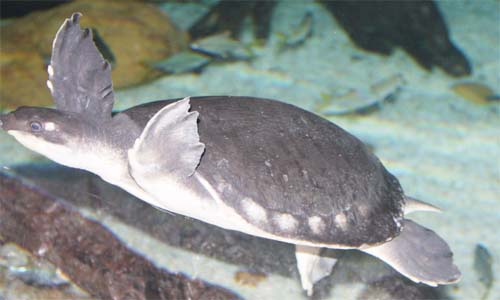
Family-2: Chelydridae
- The family Chelydridae contains only extant genera (Chelydra and Macrochelys), commonly called snapping turtles and they are endemic to the Western Hemisphere.
- They are large aquatic turtles with a long tail with three rows of tubercles and a hooked beak.
- They have a keeled, posteriorly serrated carapace with a reduced, cruciform, hinge less plastron. In this case, each side of the carapace bears 11 marginal scutes.
- The scutes of the abdominal region of plastrons are reduced. The carapace and plastron are connected by a narrow bony bridge.
- The skull roof of posterior part is deeply emarginated.
- The size of the body ranges from 18–80 cm (7.1–31.5 inches) in length with up to 113 kg in weight. In this case, the male is larger than the female.
- They reproduce during the spring or early summer and the female lays up to 109 eggs per clutch per year.
Examples: Alligator snapping turtle (Macrochelys temminckii), Common snapping turtle (Chelydra serpentina), etc.
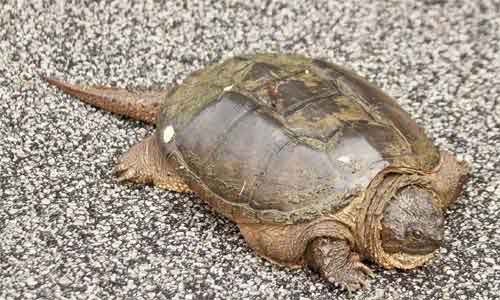
Family-3: Dermatemydidae
- The family Dermatemydidae contains only one species, known as Central American river turtle or river turtle (Dermatemys mawii).
- It inhabits large river and lakes of Central America.
- It is totally aquatic which grows up to 65 cm in length.
- The body of the river turtle is olive to gray in color with no keel in a carapace.
- It has a small head with a pointy snout.
- The carapace is somewhat flat, heavy, and smooth.
- The lower shell or plastron is yellow or cream color which connects the upper shell or carapace by the bony bridge.
- The feet are webbed.
- The female is generally larger than the male. In this case, the upper surface of the head of male bears a large yellowish gold patch while the females have gray patch on the top of the head.
- It can grow up to 66 cm (26 inches) in length (carapace length) with 22 kg in weight.
- They are nocturnal and they eat mostly plants. They also prefer to eat figs and other fruits, insects, fish or mollusks.
- During the breeding period, the female makes a nest on the shore by digging a hole into soil and lays 2-20 brittle shelled eggs.
- The eggs hatch within 7-10 months when the rainy season stars up.
Examples: Central American river turtle (Dermatemys mawii)
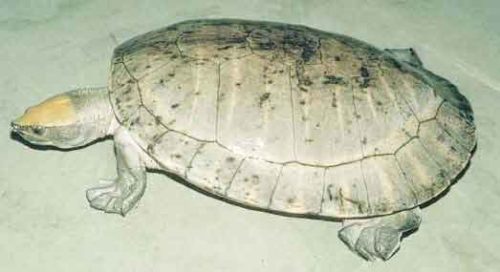
Family-4: Emydidae
- The members of the family Emydidae have several common names including Blanding’s turtle, chicken turtle, box turtle, spotted turtle, painted turtle, pond turtle, wood turtle or marsh turtles.
- The family contains over 85 living species in 25 genera.
- They have small to moderate sized body having depressed, domed, or strongly keeled carapace.
- The body size ranges from 5 inches (12 cm) to 24 inches (60 cm) in length or more.
- The males are generally smaller than the females
- They are carnivorous to strictly herbivorous. The carnivorous species mainly feed on annelids, crustaceans and fish.
- They inhabit wide variety habitats including freshwater rivers, streams, lakes, and ponds, estuaries and coastal waters. Some species are semi-aquatic to fully terrestrial.
- During the breeding season (spring), the female lays up to 24 eggs in the holes. The eggs hatch within 2-3 months. The female does not show no care for the eggs and their babies.
Examples: Pond or water turtles, Red-eared slider (Trachemys scripta elegans)
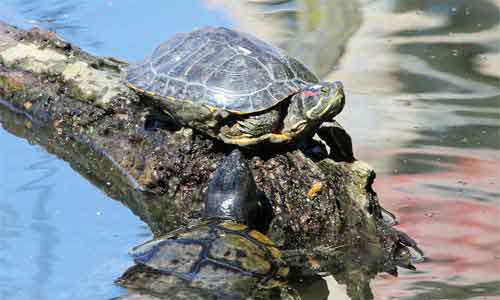
Family-5: Kinosternidae
- The family Kinosternidae contains 25 species under four genera.
- They are generally small in size which range from 3-15 inches (8-38 cm) in length.
- The shell is brown or black with oblong and moderately domed shaped while the head is greatly enlarged with sensory barbels on the chin.
- They have dark-olive to black color skin with two prominent yellow lines, of which one runs from the snout to the neck while the other one on both sides of the eye.
- They inhabit nearly any freshwater aquatic system. They prefer to live in slow-moving or still waters where vegetation available.
- They are primarily carnivorous and their food consists of snails, clams, annelids, crustaceans, insects, amphibians, small fish and sometimes carrion.
- The female lays up to 12 eggs in each clutch and eggs need long time to hatch (75 days to a year).
Examples: Mud or musk turtles, Common musk turtle (Sternotherus odoratus), Tabasco mud turtle (Kinosternon acutum), Yellow mud turtle (Kinosternon flavescens), etc.
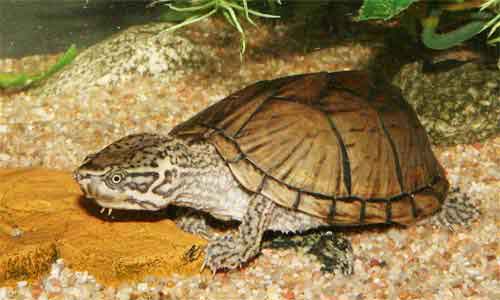
Family-6: Platysternidae
- The family Platysternidae contains only one species, known as the bigheaded turtle (Platysternon megacephalum).
- It has small to medium-sized body with up to 40 cm in length.
- It has huge sized triangle head which is covered by a hard scute.
- The upper shell or carapace is quite flat with yellow to dark-brown color.
- The lower shell or plastron is yellow in color which covers most of the underside.
- The tail is long and muscular with scaly and the toes are slightly webbed with strong claws.
- The member of the family Platysternidae lives in only in small rocky and mountain streams of China, Laos, Myanmar, Thailand, and Vietnam. It prefers to live in fast moving water bodies with a temperature of 12-170C.
- The big-headed turtle is carnivorous and feeds on insects, crustaceans, mollusks (snails and clams), and other small invertebrate.
- During the breeding season (May to August), the female lays one to four eggs in nest. The eggs need to hatch between 103 and 110 days.
Examples: Big-headed turtle (Platysternon megacephalum)
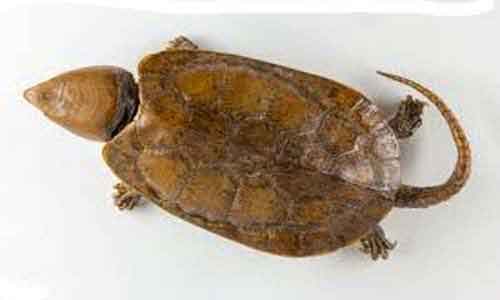
Family-7: Chelidae
- The members of the family Chelidae are commonly called the side-neck turtles or snake-necked turtles.
- They are distributed in tropical to temperate regions of Australia and New Guinea, some parts of Indonesia, and South America.
- They are primarily aquatic and inhabit freshwater rivers, lakes, streams, seasonal wetlands and ponds but some species live in estuaries and coastal waters.
- The forelimbs bear five claws while in hind limbs contain four claws.
- The neck is extremely elongate which may exceed that of the carapace.
- The carapace is dark and cryptic while the plastron has bright red, pink, orange, and yellow colors.
- They are carnivorous and mainly feed on invertebrates, gastropods and fish,
- They breed during the spring and summer and they typically build nests.
- The female lays up to 28 brittle-shelled eggs per clutch. Eggs need to hatch more than 200 days
Examples: Austro-American sideneck turtles, Common snakeneck turtle (Chelodina longicollis)
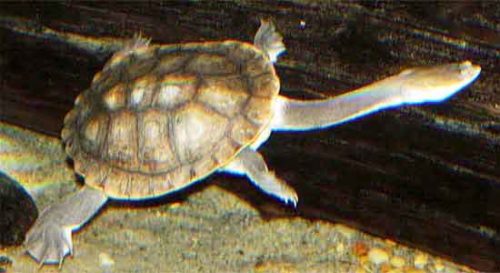
Family-8: Pelomedusidae
- The members of the family Pelomedusidae are commonly called African side-necked turtles.
- They are freshwater turtles, distributed in Africa, South America Madagascar, and the Seychelles Islands.
- The family Pelomedusidae contains about 26 species in five genera.
- They primarily live in temporary ponds, large rivers, and swamps.
- Generally, the carapace is oval in shape with some shade of olive coloration.
- The size of the upper shell or carapace ranges from 12 to 107 cm in length.
- The members of the family Pelomedusidae prefer to live in the bottom region of rivers or shallow lakes.
- They are carnivorous and mainly feed on insects, crustaceans molluscs, worms, fishes, and amphibians. But some are omnivorous and eat fallen fruits and aquatic vegetation.
- They are egg layers and the female lays up to 100 eggs per clutch.
Examples: Afro-American sideneck turtles, African helmeted turtle (Pelomedusa subrufa)
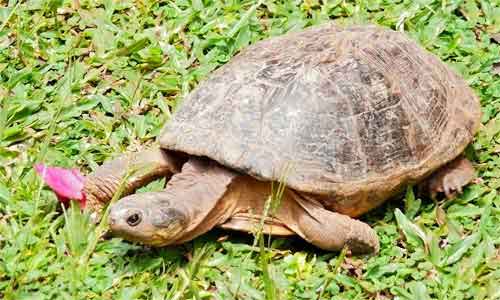
Family-9: Podocnemididae
- The members of the family Podocnemididae are commonly called side-necked turtles.
- They are native to Madagascar and northern South America.
- They are all aquatic and prefer to live in freshwater habitats including permanent slow streaming rivers, flooded forests, lakes and backwaters. But some hatchling and juvenile turtles travel into smaller rivers.
- The head is very large and shell is hard, streamlined with brown in color.
- The size of the body reaches a length of 17-20 inches (43-50 cm).
- The soft pattern of fine black lines is present on the shell of the young turtles which disappear with age.
- The members of the family Podocnemididae are primarily herbivorous and mainly feed on fruits, leaves, stems, and grasses. Occasionally, they also take freshwater sponges, crustaceans, insects, mollusks and fish.
- During the breeding season, the female comes ashore and build a nest on sandbars and river banks. She lays 10- 25 leathers, textured elongated eggs into the nest. Eggs need to hatch 40–149 days.
Examples: Madagascar big-headed turtle (Erymnochelys madagascariensis)
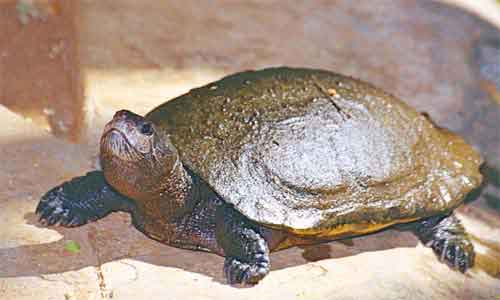
Family-10: Testudinidae
- The representatives of the family Testudinidae are commonly known as Tortoises.
- They are strictly terrestrial.
- They have high-domed carapaces and frequently with distinct growth rings.
- Plastrons are large in size.
- They have column-like or elephantine hind limbs.
- The infront of forelimbs is covered with thick scales with all the toes are without webs.
- In general, they can live up to 150 years.
- They are oviparous and can lay up to 20 eggs.
- The eggs hatch within 120 days.
Examples: Tortoise, Aldabra giant tortoise (Geochelone gigantea)
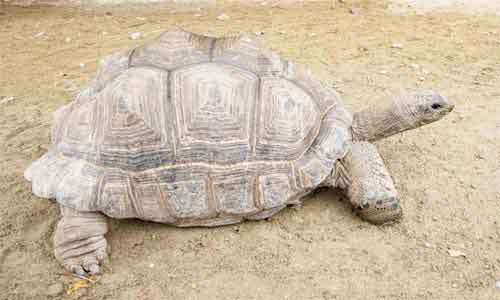
Family-11: Geoemydidae
- The family Geoemydidae includes turtles that have oval to oblong and moderately domed or flattened carapaces.
- Plastrons are large in size and occasionally hinged.
- The skull contains epiterygoid and the internal carotid canal in the pterygoid.
- The carapace has 11 pairs of sutured peripherals around its margin and nuchal without costiform processes.
- The size of the body varies from about 10 to 80 cm (4 to 30 inches) in length.
- Their neck withdraws vertically.
- The carapace bears 24 marginal scutes.
- The plastron contains12 scutes with no mesoplastron.
- They inhabit wide variety habitats including tropical forests freshwater ecosystems and, coastal marine areas.
- Most of them are herbivorous, but some species are omnivorous or carnivorous.
Examples: Asian river, leaf, roofed, Asian box turtles or Malayan box turtle (Cuora amboinensis)
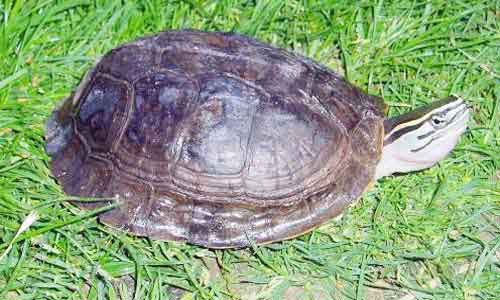
Family-12: Trionychidae
- The members of the family Trionychidae are commonly known as the soft-shelled turtles.
- The head and the neck are completely retractile.
- The carapace and plastron are covered by a continuous layer of soft skin with no epidermal scutes.
- The side of the hinder portion of carapace is quite flexible.
- Limbs are fully webbed with only three claws on each foot.
- Forelimbs are semi-paddle shaped.
- Soft, elongated and snorkel-like nostrils are present.
- Most of the members are predominantly carnivorous but some species eat plant matters. In this case of carnivorous species, food mainly consists of fish, crustaceans, snails, amphibians, aquatic birds and small mammals.
Examples: Softshell turtles/Spiny softshell turtle (Apalone spinifera)
Family-13: Chelonidae
- They are the typically large marine turtles with six extant species.
- They have a flat streamlined wide and rounded shell.
- The forelimbs bear almost paddle-like flippers.
- The body size of the sea turtles ranges from 71 to 213 cm. In this case, the Kemp’s Ridley is the smallest turtle species with a shell size about 75 cm and 50 kg of weight.
- The carapace and plastron are covered by horny epidermal shields.
- The neck is incompletely retractile.
- The legs are modified to form swimming paddles with scale covering feet.
- The digits of forelimbs are much elongated with one or two claws.
Examples: Green sea turtle (Chelonia mydas), Hawksbill sea turtle (Eretmochelys imbricata), Flatback sea turtle (Natator depressus), Olive ridley sea turtle (Lepidochelys olivacea), Kemp’s ridley sea turtle (Lepidochelys kempii), Loggerhead sea turtle (Caretta caretta).
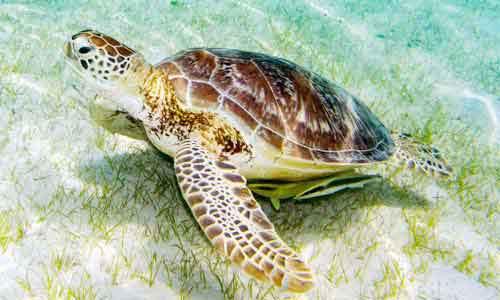
Family-14: Dermochelidae
- This family contains only one extant species, Dermochelys coriacea, found worldwide in oceans.
- The size of the body reaches up to 244 cm in length and over 800 kg in weight.
- The dorsal bony shell is composed of numerous small different sizes polygonal plates.
- The entire body of the turtle is covered with rubber-like skin.
- They are oviparous and the female lays eggs six times within a single season.
- They are pelagic feeder and feeds almost exclusively on jellyfish.
- The carapace consists of seven keels and the head cannot be fully retracted within the shell.
Examples: Leatherback sea turtle (Dermochelys coriacea)
Order-2: Rhynchocephalia
- The order Rhynchocephalia includes the only extant rhynchocephalians, the tuataras.
- They occur only on small islets off the main islands of New Zealand.
- The extant rhynchocephalians flourished around 200 million years ago but all other members became extinct in the late Cretaceous period (60 MYA).
- Along their backs have spiny crests which are made from soft, triangular folds of skin.
- The size of the tuatara ranges from 12-30 inches in length with weight between 0.5 and 2.5 pounds.
- The skin is greenish gray or speckled in colors.
- The adult tuataras have beak-like premaxilla which bears a large chisel-shaped tooth.
- They reach sexual maturity at the age between 10 and 20 years.
- The male mates each year while the female breeds every two to five years.
- They are carnivorous and take a wide variety of foods which include beetles, snails, lizards, spiders, and young seabirds.
- In wild condition, they can live up to 100 years or more.
- The tuatara contains parietal eye, situated on the top of its head and only visible in hatchlings but it becomes covered under scales and pigments after four to six months.
- They can tolerate much lower temperatures and the body temperature ranges from 41 to 52 °F whereas the body temperatures of most reptiles have around 68 °F.
- The lower jaw bears a single row of teeth while the upper jaw contains a double row of teeth.
Family-1: Sphenodontidae
- The family Sphenodontidae contains only one living member, the tuatara (Sphenodon punctatus) which occurs in New Zealand.
- They have roughly iguana-like appearance.
- Dorsal spines are present on the neck and head with a thick tail.
- They can grow up to 80 cm in length with average weight less than 1 kg.
- They are primarily nocturnal carnivorous and they mainly feed on arthropods, beetles, snails, small lizards, amphibians, and juvenile seabirds.
- They reach sexual maturity at the age between 10 and 20 years.
- They reproduce only once every 3-4 years. In this case, they mate during summer months and lay clutches of 8-15 eggs, next summer deposited in the nests. The hatchlings come out between a year and 16 months later.
- At present, they are now highly endangered due to various human activities.
Example: Tuatara (Sphenodon punctatus)
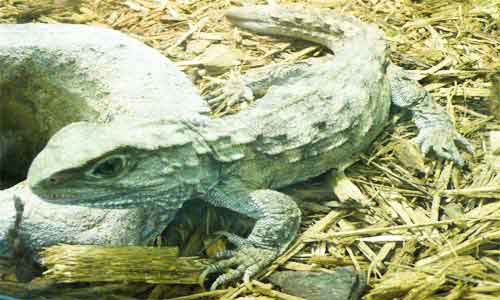
Order-2: Squamata
- The members of the order Squamata comprise the largest order of reptiles with over 10,000 species.
- They include lizards, snakes and worm lizards (amphisbaenians), collectively called scaled reptiles or squamates.
- They have horny epidermal scales or shields.
- Movable quadrate bone is present with no vomerine teeth.
- The male bears well-developed hemipenis.
- The size of the body rangs from 16 mm (dwarf gecko: Sphaerodactylus ariasae) to 5.21 meters (green anaconda: Eunectes murinus).
The order Squamata includes the following thirteen families:
- Family-1: Agamidae
- Family-2: Gekkonidae
- Family-3: Lacertidae
- Family-4: Scincidae
- Family-5: Anguidae
- Family-6: Varanidae
- Family-7: Typhlopidae
- Family-8: Acrochordidae
- Family-9: Boidae
- Family-10: Colubridae
- Family-11: Elapidae
- Family-12: Hydrophiidae
- Family-13: Viperidae
Family-1: Agamidae
- The family Agamidae contains over 350 species in 52 genera.
- They are commonly known as iguanian lizards, dragons or dragon lizards, distributed in Australia, southern Asia, and Africa.
- The body is scaly with well-developed legs and a moderately long tail.
- The average body size ranges from 4 to 6 inches (10 to 15 cm), while the tail is 8 to 12 inches (20 to 30 cm) long.
- They are ground-dwelling and arboreal species which inhabit tropical rainforests, mountain forests as well as deserts and steppes.
- They possess keeled scales, throat flaps or fans and middorsal crests.
- The males have more brightly colored than females.
- They are generally diurnal and their foods consist of insects and spiders, nestling birds, small reptiles or mammals, flowers or other vegetable matter.
- Most of them are oviparous.
Examples: Laungwala long-headed lizard or Rajasthan toad-headed lizard (Bufoniceps laungwalaensis), Ground agama (Agama aculeata), Southern rock agama(Agama atra),etc.
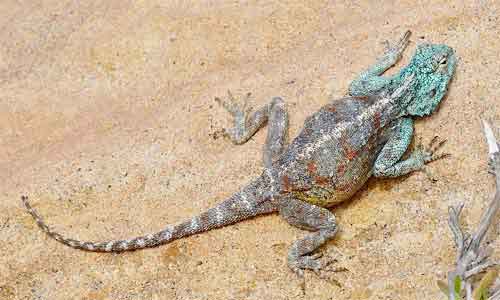
Some popular and well-known lizards under the Agamidae family:
- Agama Lizard
- Bearded Dragon
- Common Gliding Lizard
- Changeable Lizard
- Earless Agamid
- Ground Agama
- Five-banded Gliding Lizard
- Water Dragon
- Green Crested Lizard
- Southern Rock Agama
- Red-headed Rock Agama
- Uromastyx
- Spotted Gliding Lizard
Family-2: Gekkonidae
- The members of the family Gekkonidae are called the common geckos.
- This family contains over 950 known species in 61 genera, occur globally.
- The size of the body ranges from 1.2 -10 inches. The Jaragua sphaero (Sphaerodactylus ariasae) is the smallest gecko which grows up to 0.63 inch in length while the largest gecko is the New Caledonian giant gecko (Rhacodactylus leachianus), grows more than 10 inches in length.
- They have short, somewhat flattened bodies with large heads and eyes.
- The limbs are well-developed with well-developed claws. In some species, the base or tips of toes bear expanded pad that permit adhesion to smooth surfaces.
- They are carnivorous and mainly feed on insects, worms but larger species eat small-sized birds, reptiles and mammals while some other take small amount of plant matter such as moss.
- They are oviparous and the female gecko lays 2 sticky white color eggs. The eggs hatch between one and three months.
Examples: Aaron Bauer’s house gecko (Hemidactylus aaronbaueri), Tokay gecko (Gekko gecko), Andaman Islands day gecko (Phelsuma andamanense), Mourning gecko or common smooth-scaled gecko(Lepidodactylus lugubris), Narrow-tailed four-clawed gecko (Gehyra angusticaudata),etc.
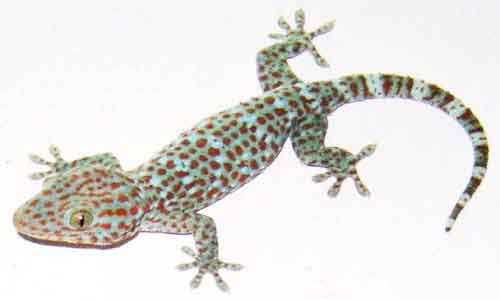
Family-3: Lacertidae
(Wall lizards, Rock lizards, and their relatives)
- The members of the family are known as the wall lizards, true lizards, or sometimes simply lacertas which are native to Asia, Europe, Africa and the East Indies.
- It is a diverse family which contains approximately 300 species in 39 genera.
- They have small to medium-sized elongated body with conical head on distinct neck.
- The tail is moderately long and thick.
- The limbs are well-developed; the hind limbs are distinctly larger than the forelimbs.
- The back of the body bears small beaded scales while the belly contains square or rectangular scales.
- The body possesses different colors and patterns. In this case, the males show more spectacular colors than the females.
- The body size ranges from 8 inches (20 cm) to 20 inches (50 cm) in length.
- They prefer to live in deserts, forests, grasslands.
- Some species of lacertas eat insects, seeds and fruits but other takes almost only plant material.
- The lacertas reproduce during spring to early summer. The female builds a hole in the ground and lays 10-20 eggs at a time. The eggs hatch between three or four months.
Examples: Atlantic Lizard (Gallotia atlantica), Spanish algyroides, Spanish keeled lizard (Algyroides marchi), Greek rock lizard (Hellenolacerta graeca), Maltese wall lizard (Podarcis filfolensis), etc.
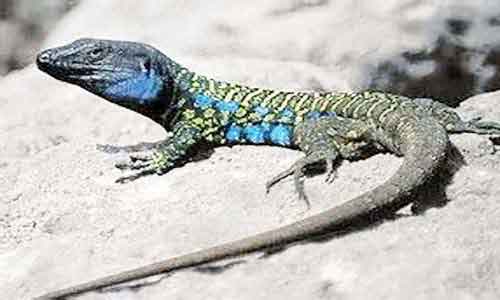
Family-4: Scincidae
- The members of the family Scincidae are commonly called skinks. This family contains over 1500 known species under over 100 genera.
- The skinks have true lizard-like body with relatively small legs and long tapering tails.
- The size of the body of skink ranges from 7.5-76 cm (3.0-30 inches) in length. In this case, the body size of the smallest skink (Scincella lateralis) ranges from 7.5 to 14.5 cm (3.0 to 5.7 in) in length, on the other hand the largest skink is the Solomon Islands skink or the prehensile-tailed skink (Corucia zebrata) which grows up to 76 cm (30 in) in length.
- They body of the skink is covered by smooth, shiny cycloid scales which makes the body shiny appearance.
- Most of the skinks are arboreal and diurnal.
- Skinks are carnivorous and their food consists of various invertebrates such as flies, grasshoppers, beetles, crickets, and caterpillars, millipedes, centipedes, earthworms, slugs, snails, isopods, moths, small lizards and small rodents. But large species are herbivorous and they eat various types of fruits.
- Some skink species are egg layers while others are viviparous which gives birth to babies.
Examples: Inland snake-eyed skink (Cryptoblepharus australis), Noble snake-eyed skink (Cryptoblepharus exochus), Dark-sided emoia, dark-sided skink, dateline emoia (Emoia adspersa), Red-throated cool-skink, red-throated skink (Acritoscincus platynota), Kinghorn’s snake-eyed skink (Austroablepharus kinghorni), Guinea lidless skink (Panaspis africanus), Alpine bog skink ( Pseudemoia cryodroma), etc.
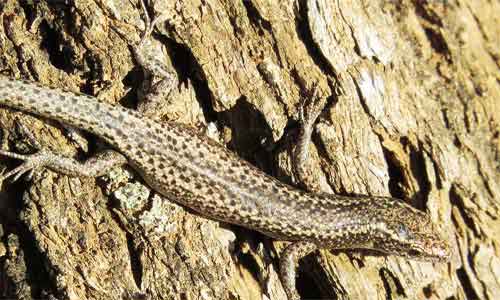
Family-5: Anguidae
- The family Anguidae contains 112 species in 14 genera.
- They are small to large lizards with reduced or absent limbs.
- The body is elongated with size ranges from 10 cm to 1.5 meters in length.
- They are distributed in North Africa, North and South America, Europe, and Asia.
- They occur in wide variety of habitats including coastal dunes, desert, grasslands, pine flatwoods, cloud forest, pine-oak forest, tropical wet forest, etc.
- The anguids are carnivorous or insectivorous, and the small sized lizard mainly feeds on insects while the larger species hunt amphibians and small reptiles.
- They exhibit various body colorations; many have bronze or brown shade, but some have more striking coloration with boldly patterned.
- Osteoderms (small bony elements) are present below the dorsal and ventral scales.
- Generally, a lateral fold present which separates the dorsal and ventral scales on each side.
- Most species have external ear opening but many species do not have it.
- In some species, the tail is shorter than the body but some have much longer tail.
- They are both viviparous and oviparous. Among them, some give birth to one to two babies while some lay eggs.
Examples: Common slowworm (Anguis fragilis), Peloponnese slowworm (Anguis cephallonica), Hainan glass lizard (Dopasia hainanensis), Wegner’s glass lizard (Dopasia wegneri), Slender glass lizard (Ophisaurus attenuatus), etc.
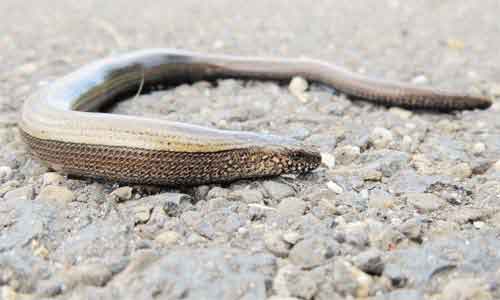
Family-6: Varanidae (Monitor Lizards)
- The members of the family Varanidae are commonly referred to as the monitor lizards or simply monitors.
- The body is sturdy with a small head, long neck and long powerful tails.
- The komodo dragon (Varanus komodensis) is the largest species which grows up to 3.1 m long with 250 kg in weight while the smallest species is Pygmy goanna (Varanus brevicaudatus) which can grow up to 23 cm in length.
- The tail is long, muscular with a formidable weapon.
- The family Varanidae comprises over 60 species under the genus Varanus.
- They are distributed in central and southern Asia, Africa, islands of Malaysia and Indonesia, Australia and Papua New Guinea.
- They inhabit wide variety of habitats including dry deserts, grasslands, lush forests and swamps.
- They eat wide variety of foods; some eat mollusks and fruits, other take lizards, eggs, and young mammals and birds while komodo dragon hunts large mammals such as buffalo, monkeys, adult birds, wild pigs and deer.
- During the breeding season, after mating, the female lays two to sixty eggs in underground burrows, or termite nests or ground-built bird nests. The eggs need to hatch four to eight months.
Examples: Savannah monitor (Varanus exanthematicus), Desert monitor (Varanus griseus), Komodo dragon (Varanus komodoensis), Peach throat monitor (Varanus jobiensis), Water monitor (Varanus salvator), Emerald tree monitor (Varanus prasinus), Crocodile monitor (Varanus salvadorii), Lace monitor (Varanus varius), etc.
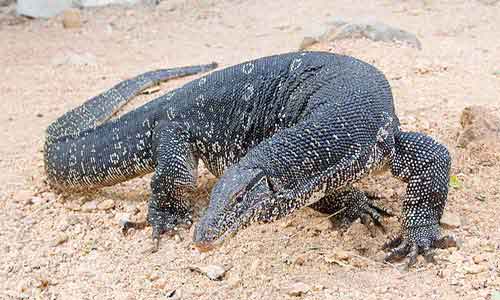
Family-7: Typhlopidae
- They are commonly known as blind snakes with currently over 200 species under 18 genera.
- They are distributed in Asia, Africa, the Americas, Australia and many islands.
- They have tube-shaped smooth and shiny bodies with the body, head, and tail have about the same diameter.
- The Schlegel’s beaked blind snake or Schelegel`s giant blind snake (Afrotyphlops schlegelii) is the largest species, grows up to 95 cm in length but most species are less than 20 cm long.
- The belly does not contain scales; eyes are dot-like, covered by head shields.
- All typhlopids have transversely placed movable maxillae with teeth and toothless dentaries.
- All members of typhlopidae possess tracheal lung and the left lung is commonly absent.
- They are very fast eaters, and their main food consist of ants, termites, worms, and other small invertebrates.
- Most typhlopids are oviparous but Typhlops diardi is ovoviviparous.
- Small sized species lay few eggs while larger species lay more than fifty eggs.
Examples: Beaked worm snake, beaked blind snake, or beak-nosed worm snake(Grypotyphlops acutu), Brahminy blind snak (Indotyphlops braminus), Long-tailed blindsnakes, long-tailed blind snakes, Arboreal blind snake (Ramphotyphlops angusticeps), Christmas Island blind snake (Ramphotyphlops exocoeti), etc.
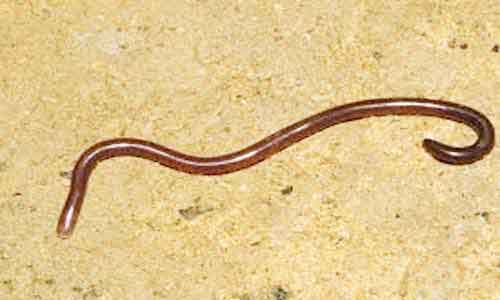
Family-8: Acrochordidae
- The members of the family Acrochordidae are commonly known as wart snakes, Java wart snakes, , elephant trunk snakes, file snakes or dogface snakes.
- The skin bears numerous small, granular scales, which project from the skin giving it a rugose texure; hence their other common name, the file snakes.
- The scales do not overlap and the interstitial skin forms bristle-tipped tubercles.
- The head and the body are covered with small, granular or tuberculate, juxtaposed scales.
- Eyes are located on the top rather than the sides of their heads.
- They do not have broad belly scales found on most other snakes.
- 7. They are distributed in Southeast Asia, the Philippines, Indonesia, New Guinea, Mussau Island, Guadalcanal Island, the Solomon Islands, etc.
- The family Acrochordidae contains 3 species in one genera and the adult Acrochordids grows between 60 cm and 2.43 m in length with over 10 kg in weight.
- They inhabit diverse habitats including freshwater rivers, lakes, mudflats, mangroves, reefs, and open seas.
Examples: Arafura File Snake (Acrochordus arafurae), Little wart snake (Acrochordus granulatus), Elephant trunk snake, Javan file snake(Acrochordus javanicus), etc.
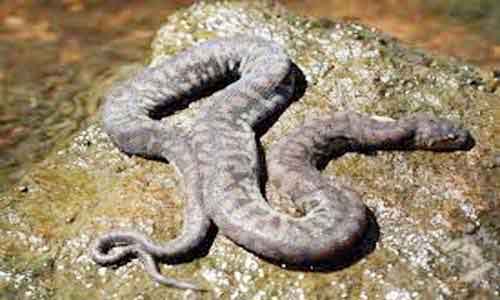
Family-9: Boidae
- The members of the family Boidae are commonly known as Boas and pythons,
- The family contains recognized 49 species in 12 genera, has a wide spread distribution with great diversity in the tropics, some species however, live in cool temperate habitats.
- The size of the body ranges from 1.2–25 ft (0.37–7.7 m) in length with up to over 145 kg in weight.
- Boas are typically stout bodied and short tailed with no teeth while pythons have teeth.
- They inhabit variety of habitats including loose sand, burrows, forest, grasslands, savanna, and various freshwater habitats.
- Boas give birth to young whereas python lays eggs.
- Both have two lungs instead of the usual one and most boids have vestigial hind limbs. The vestigial hind limbs of the boids are apparently functional structure used in courtship.
- Boids are primarily ambush hunters and consume vertebrate prey like, lizards, other snakes, small mammals, etc.
- All boids are live-bearer and give birth to live young.
Examples: Amazon Basin emerald tree boa (Corallus annulatus), Rainbow boa (Epicrates cenchria), Green anaconda (Eunectes murinus), Cuban boa(Chilabothrus angulifer), etc.
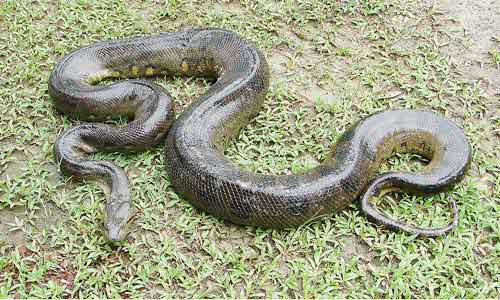
Family-10: Colubridae
- They are commonly known as colubrids which are the advanced snakes often referred to as a trash-can taxon.
- It is the largest snake family containing a variety of snakes with 249 genera comprising almost 75 percent of all the world’s snake species.
- Their body size ranges from about 6 inches (15.2 cm) to 144 inches (3.7 meters) in length.
- They have single or two lungs with the left one extremely reduced.
- Usually, the belly scales are as wide as the body.
- Teeth are normally present on the maxillary, palatine, pterygoid and dentary or lower jaw but are never found on the premaxillary.
- Most species have solid teeth without groves without any venom glands connection.
- Some species though venomous, none of these have true fangs.
- Colubrids eat wide variety of foods and their food consists of mammals, lizards, baby turtles, frogs and toads, fishes, tarantulas, earthworms, scorpions, some other insects, etc.
Examples: Graham’s crayfish snake (Regina grahamii), Queen snake( Regina septemvittata), Dary’s burrowing snake (Adelphicos daryi), Black-collared snake (Drepanoides anomalus), Banded cat-eyed snake(Leptodeira annulata),etc.
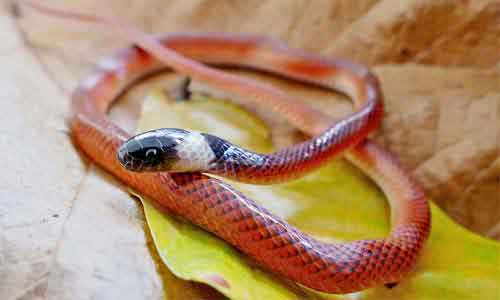
Family-11: Elapidae
- The members of the family Elapidae are commonly known as elapids.
- This family comprises of some 360 species in 56 genera, endemic to tropical and subtropical regions around the world.
- They have long and slender body with smooth scales.
- The head is covered with large shields and eyes with round pupils.
- They have a wide range of body sizes. The world`s longest venomous snake is the king kobra (Ophiophagus hannah) which grows up to 5.85 m (19.2 ft) in length.
- Most elapids are oviparous and they lay eggs.
Examples: South Andaman krait (Bungarus andamanensis), Indian cobra, spectacled cobra (Naja naja), king cobra (Ophiophagus hannah), Goldie’s tree cobra (Pseudohaje goldii), Rough-scaled snake (Tropidechis carinatus), Lake Cronin snake (Paroplocephalus atriceps), etc.
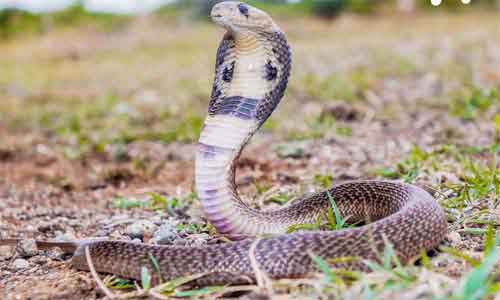
Family-12: Hydrophiidae
- The members of the family Hydrophiidae are commonly known as sea snakes.
- The family contains 69 described species in 17 genera, distributed in the Indian and Pacific Oceans.
- Sea snakes produce venom which they injects through fixed fangs, positioned at the front of the mouth.
- The tails are vertically flattened to act as paddles and help propel them through the water.
- The body is laterally compressed which gives eel-like appearance.
- The body size ranges from 120-150 cm (3.9 – 4.9 ft) in length. The largest sea snake is the Hydrophis spiralis, which grows up to 3 m (9.8 ft) in length.
- They have relatively small eyes with a round pupil.
- They are carnivorous and mainly feed on fish and occasionally young octopus.
- Most are ovoviviparous and give birth to young babies.
Examples: Horned sea snake, Peron’s sea snake, and the spiny-headed seasnake (Hydrophis peronii), Short-nosed sea snake (Aipysurus apraefrontalis), Tokes’s sea snake (Hydrophis stokesii), Turtle-headed sea snake or egg-eating sea snake(Emydocephalus annulatus), Beaked sea snake, Hook-nosed sea snake, Common sea snake (Enhydrina schistosa), Grey’s mudsnake, Mangrove seasnake (Ephalophis greyae), Bighead sea snake, Annandale’s sea snake (Hydrophis annandalei), etc.
Family-13: Viperidae
- Vipers are probably the best known of all snakes.
- They have broad, roughly triangular heads and most are also heavy-bodied with relatively short, slender tails.
- They produce venom, which they inject using long, hinged fangs at the front of their mouth.
- Vipers are diverse group occurring on all continents except Australia.
- They include aquatic to arboreal species, range from sea level to the tree line, and occur in near rainless desert to evergreen rain forest.
- They prey on invertebrates and vertebrates.
- Pit vipers, uniquely characterized by a local pit organ on each side on the heads which include them to detect the body heat of their prey.
Examples: Gloyd’s cantil, Gloyd’s moccasin southern cantil (Agkistrodon howardgloydi), Central American jumping pit viper (Atropoides mexicanus), Common lancehead (Bothrops atrox), Chasen’s mountain pit viper (Garthius chaseni), Sri Lankan hump-nosed viper (Hypnale nepa), etc.
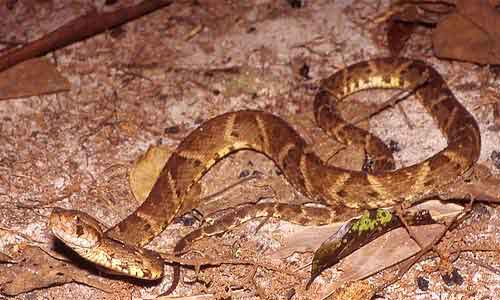
Order-4: Crocodylia
- The order Crocodylia includes the alligators, gharials, caimans and crocodiles.
- They are the only ectothermic reptiles with four-chambered heart.
- They are the predatory semi-aquatic reptiles, commonly called crocodilians.
- They have long flattened snouts with laterally compressed tails.
- The body is long with large and long head.
- Jaws are powerful with sharp teeth.
- They have well-developed limbs. In this case, hind limbs are heavier and larger than the forelimbs.
- The fore feet are un-webbed with five digits while the hind feet are strongly webbed with four fully developed digits.
- They are carnivorous and their food consists of mainly insects, crustaceans, molluscs, birds, fishes, reptiles and mammals.
- They are oviparous and some crocodiles make the mound-nests of vegetation and soil while other digs their nests in loose soils using their head and limbs.
- Females guard their nests and assist the young to escape from their eggshells and the nests.
- The body size of the crocodilians range from 1 meter to 7 meters. In this case, the saltwater crocodile grows up to 7 m with 2,000 kg in weight.
The order Crocodylia includes the following three families:
- Family-1: Crocodylidae
- Family-2: Gavialidae
- Family-3: Alligatoridae
Family-1: Crocodylidae
- The members of the family Crocodilidae are commonly known as crocodiles.
- The family Crocodylidae contains a total of 15 species.
- They are all aquatic but frequently bask in the sun on shore.
- They have long, strong tail which is used for swimming and is also powerful weapon of offense or defense.
- Each jaw bear 14-24 sharp teeth, used for seizing but not for chewing.
- They lay large, hard-shelled eggs either in a shallow excavation on a sandy shore or in a nest piled by the mother.
- The head is long and narrow with more V-shaped snouts.
- The upper jaw of alligator is wider than its lower jaw while in crocodiles, the lower and upper jaws are the same width.
Examples: Mugger crocodile (Crocodylus palustris), Saltwater crocodile (Crocodylus porosus), Freshwater crocodile (Crocodylus johnsoni), Borneo crocodile (Crocodylus raninus), Cuban crocodile (Crocodylus rhombifer), Siamese crocodile (Crocodylus siamensis), Dwarf crocodile (Osteolaemus tetraspis), Central African slender-snouted crocodile (Mecistops leptorhynchus), etc.
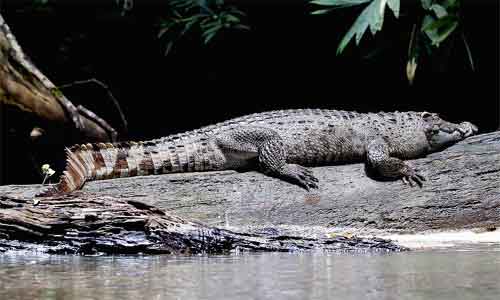
Family-2: Gavialidae
- The family Gavialidae contains only two extant species; the gharial (Gavialis gangeticus), which is native to India and Nepal and the false gharial or Malayan gharial (Tomistoma schlegelii), native to Peninsular Malaysia, Borneo, Sumatra, and Java.
- They are the large semi-aquatic reptiles having much thinner and elongated snouts.
- They can grow up to 6.5 meters in length.
- The body is strongly armored with nuchal and dorsal scutes.
- They inhabit deep and fast flowing rivers.
- The female reaches sexual maturity at the age of 10 years.
- They are carnivorous and entirely feed on fish, insects and frogs.
- They are oviparous and the female lays 30-50 eggs in their prepared nests.
- They have partially webbed fingers and toes.
Examples: Gharial (Gavialis gangeticus), False gharial (Tomistoma schlegelii), etc.
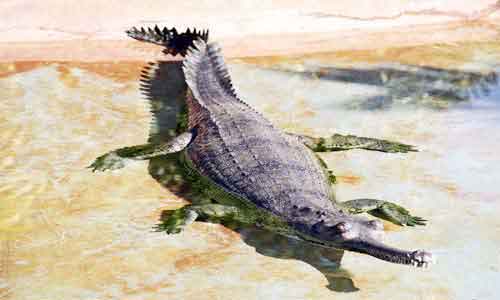
Family-3: Alligatoridae
- The family Alligatoridae includes the alligators and caimans with extant 4 genera and 8 species.
- The head is wider and shorter with larger, broader and more obtuse snouts.
- They can adept to survive colder temperature than crocodylids.
- They are less aggressive than crocodylids.
- They can grow up to 18-20 feet in length.
- The fourth tooth of the lower jaw fit inside those of upper jaw.
Examples: American alligator (Alligator mississippiensis), Chinese alligator (Alligator sinensis), Black caiman (Melanosuchus niger), Yacare caiman (Caiman yacare), Smooth-fronted caiman (Paleosuchus trigonatus), etc.
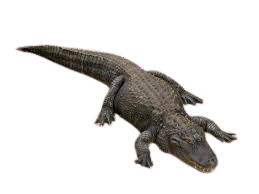
Concluding Remarks
Most of the reptiles, particularly the snakes and lizards are beneficial. Reptiles play as an important part of the food webs in most ecosystems. They constitute one of the most important biological control agents through feeding on harmful rodents and insects. They also prevent overpopulation and provide food for hungry predators. Snakes are major predators of rodents. Some herbivorous reptile species play a key role for the dispersion of seed and also act as pollinators. Besides these, many people regularly harvest the turtles, lizards, snakes, and crocodiles as food for local consumption in many countries. Some snakes, however, prey on eggs of game and other birds in their breeding seasons. Skin of crocodiles and some snakes are used for fancy leather to make vanity bags, shoes, and other leather goods. At present, many species have gone to extinct due to over exploitation and various illegal human activities. The absence of them allows agricultural pest populations to explode. Some conservation measures should be taken to protect the valuable reptile species from their extinction near the future.

